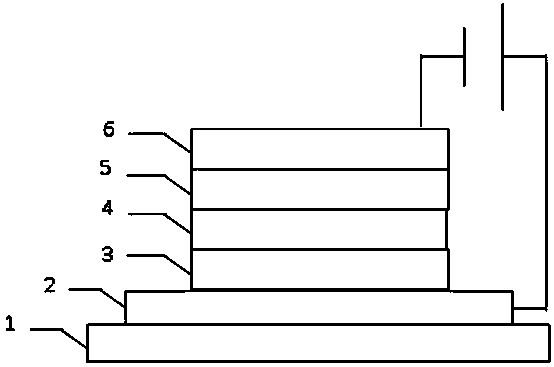Nanometer material and preparation method thereof, and quantum dot light emitting diode
A technology of quantum dot light-emitting and nanomaterials, applied in the field of quantum dot light-emitting devices, can solve the problem of low hole transport efficiency, and achieve the effects of improving hole transport efficiency, simple preparation method, and improving luminous efficiency and performance.
- Summary
- Abstract
- Description
- Claims
- Application Information
AI Technical Summary
Problems solved by technology
Method used
Image
Examples
Embodiment 1
[0057] Example 1: The following is a detailed introduction by using ammonium molybdate, concentrated nitric acid, and ammonium sulfide to prepare nanomaterials as an example.
[0058] (1) Add 1 g of ammonium molybdate to 20 mL of water, and after it is completely dissolved, add 3 mL of concentrated nitric acid, and stir for 30 min. Then transferred to the hydrothermal reactor, at 200 o The reaction was carried out at C for 24 h, followed by cooling, washing (2 times with water, 1 time with absolute ethanol), followed by cooling at 50 o drying under C to obtain MoO 3 Nanoparticles;
[0059] (2) The dried MoO 3 Nanoparticles, ultrasonically dispersed in 20 mL of mixed solution of water and ethanol (volume ratio of water and ethanol is 2:3), to obtain homogeneous MoO 3 After the nanoparticle dispersion liquid, 0.1 g of ammonium sulfide was added, and the dispersion liquid was transferred to a hydrothermal reactor, at 200 o The reaction was carried out at C for 24 h, followed...
Embodiment 2
[0060] Example 2: The following is a detailed description of the preparation of nanomaterials by using sodium molybdate, concentrated sulfuric acid and thiourea as an example.
[0061] (1) Add 1 g of sodium molybdate to 20 mL of water, and after it is completely dissolved, add 3 mL of concentrated sulfuric acid, and stir for 30 min. Then transferred to the hydrothermal reactor, at 200 o The reaction was carried out at C for 24 h, followed by cooling, washing (2 times with water, 1 time with absolute ethanol), followed by cooling at 50 o drying under C to obtain MoO 3 Nanoparticles;
[0062] (2) The dried MoO 3 Nanoparticles, ultrasonically dispersed in 20 mL of mixed solution of water and ethanol (volume ratio of water and ethanol is 2:3), to obtain homogeneous MoO 3 After the nanoparticle dispersion, 0.1 g of thiourea was added, and the dispersion was transferred to a hydrothermal o The reaction was carried out at C for 24 h, followed by cooling, washing (2 times with wa...
Embodiment 3
[0063] Embodiment 3: The following takes the preparation of nanomaterials by using potassium molybdate, concentrated hydrochloric acid and thioacetamide as an example to introduce in detail.
[0064] (1) Add 1 g of potassium molybdate to 20 mL of water, and after it is completely dissolved, add 3 mL of concentrated hydrochloric acid, and stir for 30 min. Then transferred to the hydrothermal reactor, at 200 o The reaction was carried out at C for 24 h, followed by cooling, washing (2 times with water, 1 time with absolute ethanol), followed by cooling at 50 o drying under C to obtain MoO 3 Nanoparticles;
[0065] (2) The dried MoO 3 Nanoparticles, ultrasonically dispersed in 20 mL of mixed solution of water and ethanol (volume ratio of water and ethanol is 2:3), to obtain homogeneous MoO 3 After the nanoparticle dispersion liquid, 0.1 g of thioacetamide was added, and the dispersion liquid was transferred to a hydrothermal reaction kettle. o The reaction was carried out at...
PUM
| Property | Measurement | Unit |
|---|---|---|
| particle diameter | aaaaa | aaaaa |
| particle diameter | aaaaa | aaaaa |
| thickness | aaaaa | aaaaa |
Abstract
Description
Claims
Application Information
 Login to View More
Login to View More - R&D
- Intellectual Property
- Life Sciences
- Materials
- Tech Scout
- Unparalleled Data Quality
- Higher Quality Content
- 60% Fewer Hallucinations
Browse by: Latest US Patents, China's latest patents, Technical Efficacy Thesaurus, Application Domain, Technology Topic, Popular Technical Reports.
© 2025 PatSnap. All rights reserved.Legal|Privacy policy|Modern Slavery Act Transparency Statement|Sitemap|About US| Contact US: help@patsnap.com

